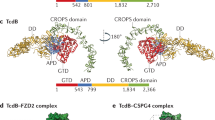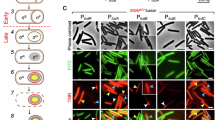Abstract
Clostridium difficile is the leading cause of infectious diarrhoea in hospitals worldwide, because of its virulence, spore-forming ability and persistence1,2. C. difficile-associated diseases are induced by antibiotic treatment or disruption of the normal gastrointestinal flora3,4. Recently, morbidity and mortality resulting from C. difficile-associated diseases have increased significantly due to changes in the virulence of the causative strains and antibiotic usage patterns1,2,5,6. Since 2002, epidemic toxinotype III NAP1/027 strains1,2, which produce high levels of the major virulence factors, toxin A and toxin B, have emerged. These toxins have 63% amino acid sequence similarity7 and are members of the large clostridial glucosylating toxin family, which are monoglucosyltransferases that are pro-inflammatory, cytotoxic and enterotoxic in the human colon8,9,10. Inside host cells, both toxins catalyse the transfer of glucose onto the Rho family of GTPases, leading to cell death8,11. However, the role of these toxins in the context of a C. difficile infection is unknown. Here we describe the construction of isogenic tcdA and tcdB (encoding toxin A and B, respectively) mutants of a virulent C. difficile strain and their use in the hamster disease model to show that toxin B is a key virulence determinant. Previous studies showed that purified toxin A alone can induce most of the pathology observed after infection of hamsters with C. difficile8,9,12 and that toxin B is not toxic in animals unless it is co-administered with toxin A, suggesting that the toxins act synergistically12. Our work provides evidence that toxin B, not toxin A, is essential for virulence. Furthermore, it is clear that the importance of these toxins in the context of infection cannot be predicted exclusively from studies using purified toxins, reinforcing the importance of using the natural infection process to dissect the role of toxins in disease.
This is a preview of subscription content, access via your institution
Access options
Subscribe to this journal
Receive 51 print issues and online access
$199.00 per year
only $3.90 per issue
Buy this article
- Purchase on SpringerLink
- Instant access to full article PDF
Prices may be subject to local taxes which are calculated during checkout



Similar content being viewed by others
References
McDonald, L. C. et al. An epidemic, toxin gene-variant strain of Clostridium difficile . N. Engl. J. Med. 353, 2433–2441 (2005)
Warny, M. et al. Toxin production by an emerging strain of Clostridium difficile associated with outbreaks of severe disease in North America and Europe. Lancet 366, 1079–1084 (2005)
Bartlett, J. G. et al. Role of Clostridium difficile in antibiotic-associated pseudomembranous colitis. Gastroenterology 75, 778–782 (1978)
Bartlett, J. G. Antibiotic-associated diarrhea. N. Engl. J. Med. 346, 334–339 (2002)
Redelings, M. D., Sorvillo, F. & Mascola, L. Increase in Clostridium difficile-related mortality rates, United States, 1999–2004. Emerg. Infect. Dis. 13, 1417–1419 (2007)
O’Brien, J. A., Lahue, B. J., Caro, J. J. & Davidson, D. M. The emerging infectious challenge of Clostridium difficile-associated disease in Massachusetts hospitals: clinical and economic consequences. Infect. Control Hosp. Epidemiol. 28, 1219–1227 (2007)
von Eichel-Streiber, C. et al. Comparative sequence analysis of the Clostridium difficile toxins A and B. Mol. Gen. Genet. 233, 260–268 (1992)
Just, I. & Gerhard, R. Large clostridial cytotoxins. Rev. Physiol. Biochem. Pharmacol. 152, 23–47 (2004)
Voth, D. E. & Ballard, J. D. Clostridium difficile toxins: mechanism of action and role in disease. Clin. Microbiol. Rev. 18, 247–263 (2005)
Jank, T. & Aktories, K. Structure and mode of action of clostridial glucosylating toxins: the ABCD model. Trends Microbiol. 16, 222–229 (2008)
Just, I. et al. Glucosylation of Rho proteins by Clostridium difficile toxin B. Nature 375, 500–503 (1995)
Lyerly, D. M., Saum, K. E., MacDonald, D. K. & Wilkins, T. D. Effects of Clostridium difficile toxins given intragastrically to animals. Infect. Immun. 47, 349–352 (1985)
O’Connor, J. R. et al. Construction and analysis of chromosomal Clostridium difficile mutants. Mol. Microbiol. 61, 1335–1351 (2006)
Heap, J. T. et al. The ClosTron: a universal gene knock-out system for the genus Clostridium . J. Microbiol. Methods 70, 452–464 (2007)
Dineen, S., Villapakkam, A. C., Nordman, J. T. & Sonenshein, A. L. Repression of Clostridium difficile toxin gene expression by CodY. Mol. Microbiol. 66, 206–219 (2007)
Mani, N. et al. Environmental response and autoregulation of Clostridium difficile TxeR, a sigma factor for toxin gene expression. J. Bacteriol. 184, 5971–5978 (2002)
Matamouros, S., England, P. & Dupuy, B. Clostridium difficile toxin expression is inhibited by the novel regulator TcdC. Mol. Microbiol. 64, 1274–1288 (2007)
Schirmer, J. & Aktories, K. Large clostridial cytotoxins: cellular biology of Rho/Ras-glucosylating toxins. Biochim. Biophys. Acta 1673, 66–74 (2004)
Torres, J., Camorlinga-Ponce, M. & Munoz, O. Sensitivity in culture of epithelial cells from rhesus monkey kidney and human colon carcinoma to toxins A and B from Clostridium difficile . Toxicon 30, 419–426 (1992)
Giesemann, T. et al. Cholesterol-dependent pore formation of Clostridium difficile toxin A. J. Biol. Chem. 281, 10808–10815 (2006)
Burger, S. et al. Expression of recombinant Clostridium difficile toxin A using the Bacillus megaterium system. Biochem. Biophys. Res. Commun. 307, 584–588 (2003)
Tang-Feldman, Y. J. et al. One-step cloning and expression of Clostridium difficile toxin B gene (tcdB). Mol. Cell. Probes 16, 179–183 (2002)
Sambol, S. P. et al. Infection of hamsters with epidemiologically important strains of Clostridium difficile . J. Infect. Dis. 183, 1760–1766 (2001)
Kim, P. H., Iaconis, J. P. & Rolfe, R. D. Immunization of adult hamsters against Clostridium difficile-associated ileocecitis and transfer of protection to infant hamsters. Infect. Immun. 55, 2984–2992 (1987)
Du, T. & Alfa, M. J. Translocation of Clostridium difficile toxin B across polarized Caco-2 cell monolayers is enhanced by toxin A. Can. J. Infect. Dis. 15, 83–88 (2004)
Drudy, D., Fanning, S. & Kyne, L. Toxin A-negative, toxin B-positive Clostridium difficile . Int. J. Infect. Dis. 11, 5–10 (2007)
Johnson, S. et al. Fatal pseudomembranous colitis associated with a variant Clostridium difficile strain not detected by toxin A immunoassay. Ann. Intern. Med. 135, 434–438 (2001)
Benson, L., Song, X., Campos, J. & Singh, N. Changing epidemiology of Clostridium difficile-associated disease in children. Infect. Control Hosp. Epidemiol. 28, 1233–1235 (2007)
Smith, C. J., Markowitz, S. M. & Macrina, F. L. Transferable tetracycline resistance in Clostridium difficile . Antimicrob. Agents Chemother. 19, 997–1003 (1981)
Simon, R., Priefer, U. & Puhler, A. A broad host range mobilization system for in vivo genetic engineering: transposon mutagenesis in gram negative bacteria. Bio/Technology 1, 784–790 (1983)
Miller, J. H. Experiments in Molecular Genetics (Cold Spring Harbor Laboratory, 1972)
Inoue, H., Nojima, H. & Okayama, H. High efficiency transformation of Escherichia coli with plasmids. Gene 96, 23–28 (1990)
Sambrook, J. & Russell, D. W. Molecular Cloning: a Laboratory Manual (Cold Spring Harbor Laboratory Press, 2001)
Carter, G. P. et al. Binary toxin production in Clostridium difficile is regulated by CdtR, a LytTR family response regulator. J. Bacteriol. 189, 7290–7301 (2007)
Lyras, D. & Rood, J. I. Conjugative transfer of RP4-oriT shuttle vectors from Escherichia coli to Clostridium perfringens . Plasmid 39, 160–164 (1998)
Lyras, D. & Rood, J. Transposition of Tn4451 and Tn4453 involves a circular intermediate that forms a promoter for the large resolvase, TnpX. Mol. Microbiol. 38, 588–601 (2000)
Razaq, N. et al. Infection of hamsters with historical and epidemic BI types of Clostridium difficile . J. Infect. Dis. 196, 1813–1819 (2007)
Clabots, C. R. et al. Development of a rapid and efficient restriction endonuclease analysis typing system for Clostridium difficile and correlation with other typing systems. J. Clin. Microbiol. 31, 1870–1875 (1993)
Acknowledgements
Research at Monash University was supported by Program Grant 284214 from the Australian National Health and Medical Research Council, funding from the ARC Centre of Excellence in Structural and Functional Microbial Genomics and grant AI057637 from the United States National Institute of Allergy and Infectious Diseases. S.J., D.N.G. and G.V. were supported by Merit Review Grants from the United States Department of Veterans Affairs Research Service. We thank D. Lyerly, K. Aktories and C. von-Eichel Streiber for providing toxin-A-specific and toxin-B-specific antibodies, K. Nagaro and A. Cheknis for assistance with the hamster experiments, V. K. Viswanathan for providing intestinal epithelial cell lines, E. Hartland for providing the HT29 cell line, and M. Merrigan for adherence assays.
Author Contributions D.L., J.R.O’C., G.P.C., V.A. and J.I.R. designed the genetic and molecular aspects of the research, which were carried out by D.L., P.M.H. and G.P.C. S.J., S.P.S., J.R.O’C. and D.N.G. planned and developed the animal experiments, which were carried out by S.P.S. and J.R.O’C. Tissue culture assays were designed, planned and carried out by D.L., G.P.C., R.P., T.P. and G.V. All authors were involved in data analysis and interpretation. The manuscript was primarily written by D.L. and J.I.R. but all authors had very significant input into its content and reviewed and edited the manuscript.
Author information
Authors and Affiliations
Corresponding author
Supplementary information
Supplementary Table
This file contains Supplementary Table S1 (PDF 46 kb)
Rights and permissions
About this article
Cite this article
Lyras, D., O’Connor, J., Howarth, P. et al. Toxin B is essential for virulence of Clostridium difficile. Nature 458, 1176–1179 (2009). https://doi.org/10.1038/nature07822
Received:
Accepted:
Published:
Issue Date:
DOI: https://doi.org/10.1038/nature07822
This article is cited by
-
Design of 8-mer peptides that block Clostridioides difficile toxin A in intestinal cells
Communications Biology (2023)
-
C. difficile intoxicates neurons and pericytes to drive neurogenic inflammation
Nature (2023)
-
Identification of TFPI as a receptor reveals recombination-driven receptor switching in Clostridioides difficile toxin B variants
Nature Communications (2022)
-
Clostridioides difficile toxins: mechanisms of action and antitoxin therapeutics
Nature Reviews Microbiology (2022)
-
Structural basis for CSPG4 as a receptor for TcdB and a therapeutic target in Clostridioides difficile infection
Nature Communications (2021)




